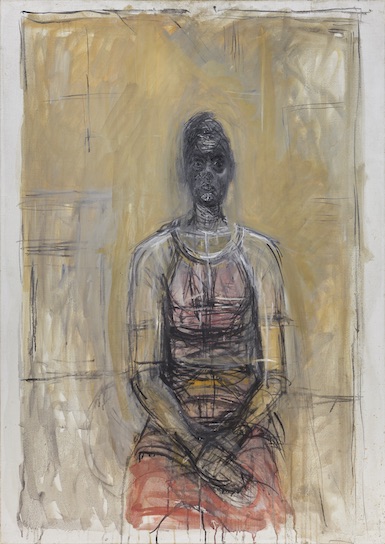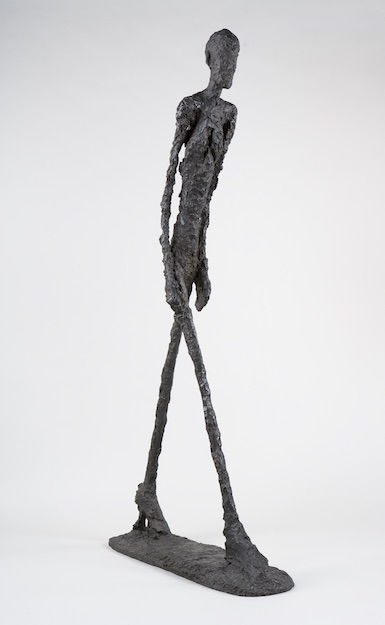[ad_1]

Alberto Giacometti painting in his Paris studio, 1958.
ERNST SCHEIDEGGER/©2018 STIFTUNG ERNST SCHEIDEGGER–ARCHIV, ZURICH
Two of this month’s most notable events relate to Alberto Giacometti: a retrospective for the sculptor at New York’s Guggenheim Museum and the opening of the Giacometti Institute in Paris, where a reconstructed version of the artist’s studio will be open for visitation. With such festivity in the air, republished below is Thomas B. Hess’s essay about Giacometti from the March 1966 issue of ARTnews, on the occasion of the artist’s death earlier that year. Hess, who was then the editor of this magazine, notes that Giacometti was “an enchanting man who was at work at the top of his powers” at the time of his death. His essay follows in full below. —Alex Greenberger
“Editorial: Alberto Giacometti, 1901-1966”
By Thomas B. Hess
March 1966
Like many of the best minds of his generation, Alberto Giacometti’s way of thinking was to cling to all sides of a contradiction. Mutually exclusive concepts bloomed openly in his philosophy, and he cultivated them with humor and passion. For example, he loathed being interrupted, and so he was elaborately polite to strangers who dropped into the studio. He was a shy man and had a natural writer’s respect for the exact word, which made him evolve a routine patter to cope with visitors. His favorite speech, which he could deliver effortlessly while concentrating on tidy up a portfolio of drawings, arranging for laundry and fretting about patinas, concerned Despair: his inability to finish anything, his profound dissatisfaction with art. “You see how badly things are going,” he would tell an intruder, gesturing at works in progress snugly hidden under damp rags, “disaster, impossible!”

Alberto Giacometti, Caroline in a Red Dress (Caroline avec une robe rouge), ca. 1964–65, oil on canvas.
©2018 ALBERTO GIACOMETTI ESTATE/LICENSED BY VAGA AND ARTISTS RIGHTS SOCIETY (ARS), NEW YORK/FONDATION GIACOMETTI, PARIS
This was the Giacometti line, and because so many of its recipients were journalists on the prowl for a quick interview, it became the artist’s public face—anguished, alienated and (with an assist from Sartre, who brilliantly wrote on Alberto) essence of the Existential.
His tragic death last January elicited obituaries all over the world which rehearsed once again the picturesque impressions of a tormented artist in his dingy workroom (actually Alberto owned a whole village of contiguous little rooms).
His despair was true enough, and the anguish, but there were other, more important sides to the artist and other moods to his work (reporters might have noticed that Alberto’s darkest utterance was offered with the brightest little grin).
Once he complained about one of his pictures of trees because “birds aren’t singing and apples aren’t growing in the branches” (I believe they were oaks, anyway). I said, “Well, what about these other pictures,” pointing to some Miros, Chagalls and Braques that were standing around the gallery. “Ha,” beamed Giacometti. “No question; mine is much better.” The big joke wasn’t that his art was particularly excruciating. All art was. And its impossibility derived from its necessity. He was like a man who, because he must breathe, resents air.
Several reporters have invoked an anecdote of Alberto’s about getting caught in a hypothetical burning house with a Rembrandt and a cat; he said he’d save the cat.
Of course. Anybody with an imagination for agony (The Scream was a great Giacometti subject) would pick up the cat.
When I saw him last, in November 1965, shortly after he had returned from his first visit to America, I congratulated him on getting two museums (the Museum and the Tate) the same number for two big, different shows. “Not bad for some one who never can finish anything,” I said. “They were beautiful,” said Alberto.
He died in Switzerland and is buried in his native village of Stampa. He used to visit there annually around Eastertime to see his mother—a monumental figure who looms in a series of pictures like a comfortable Sherman tank lumbering out of the mist.
“What does your mother think of your work,” I asked him (she was the widow of a well-known Impressionist painter). “She can’t stand them,” said Alberto grinning, “and she gets the whole village to back her up. The mailman will come by. She’ll drag out one of my new paintings and say, ‘Look, isn’t this terrible, look at the dirty colors.’ And the postman will nod his head.”

Alberto Giacometti, Walking Man I (Homme qui marche I), 1960, bronze.
©2018 ALBERTO GIACOMETTI ESTATE/LICENSED BY VAGA AND ARTISTS RIGHTS SOCIETY (ARS), NEW YORK/FONDATION GIACOMETTI, PARIS
It may be that all Giacomettis are hypercritical, but Alberto thought that his mother and the postman were being comedians.
His photographs usually show a ravaged face, half Harpo Marx, half Jesus Christ. Years of living in plaster dust had turned his skin livid, his lips were apt to be slate-blue, the whites of his eyes were yellow, the lids were rimmed in red; when he lit a cigarette you noticed that his fingernails were like petrified wood. But what the photographs don’t show is that he was a very handsome man, poised, elegant, with a smile that lit up his whole face and the whole room.
He enjoyed America and was looking forward to a project for the Chase-Manhattan Plaza, in his favorite part of New York, the Wall Street area. “Bunshaft [the architect] and I crawled all over the site with rulers,” he said. For years he had never crossed the Atlantic, first because boats were too slow (“You can’t draw the horizon for a whole week without going crazy, and I know I never could resist that horizon”) and, second, because he didn’t trust pilots (“If I was in an airplane crash, I’d die of rage on the way down”)—furthermore why go 350 miles an hour if there is no thrill (“I adore speed”)? But finally liners got faster and he arrived last autumn in time to see his show at the Museum of Modern Art.
“Coming into New York Harbor,” he said, “one realizes that if the Atlantic would rise just two centimeters, the whole of Manhattan would be flooded.” The city seemed in peril to him; so many buildings being torn down, and “where are the churches?” (Saul Steinberg has pointed out that Alberto was looking for piazzas and couldn’t recognize our mercantile-style religious architecture.) The Pierre Matisses had taken him on an art tour to Philadelphia; driving back across New Jersey, “all the meadows were running in Renoir—in reds and violets.”
Once in 1949 at a restaurant he stopped in front of a proto-Pop wood carving of a sailor grappling with the helm, like an old trade-mark of cod-liver oil, and said happily, “This is the kind of sculpture that cheers up sculptors; Chartres is discouraging.” But nothing kept him from work, and if he was a connoisseur of frustrations, he was also one of the most productive artists of his generation, in sheer number of works, and in range, medium, scale and content.

Alberto Giacometti, Three Men Walking (Large Square) (Trois hommes qui marchent [petit plateau]), 1948, bronze.
©2018 ALBERTO GIACOMETTI ESTATE/LICENSED BY VAGA AND ARTISTS RIGHTS SOCIETY (ARS), NEW YORK/FONDATION GIACOMETTI, PARIS
There were things he enjoyed doing, saw in a flash and executed so easily he felt a bit guilty about it: a huge leg coming down from the sky, for example, or an 8-foot high standing woman. Other problems would engage him for years. His last work was the head and torso of a bald friend. “Why didn’t I think of it before,” he exclaimed about a year ago; “Hair! That’s been the trouble. Hair is impossible! Now we’ll get someplace.” (The model laughed a bit smugly, proud of being so usefully bald.) Ten months later he was still working on the clay head. Now the “impossibility” had shifted, as he demonstrated with a thumbnail, to a reconstruction in sculpture of the bony triangle between the eyebrows and the base of the nose (and, of course, this particular model happened to have developed an inconceivably complex flesh structure precisely at this spot; during the conversation he tried to hide it between his fingers).
I went to see Alberto the evening before I left Paris. The light was fading. He was leaning forward on his stool, pushing his nose to an inch from the nose of the sculpture; the bald model was perched forward, too, his nose advancing as the tension in his shoulders began to tell. They made a pyramid of stress. “Hello,” I said. “Ah,” they breathed together, held the concentration for a moment, then slumped. You can barely see across the room; the light was so thick it seemed filled with plaster dust. Giacometti smiled broadly and turned on a lamp. He looked radiant. “You see,” he said, “you see,” gesturing at the bust, “no, perhaps it’s better not to look; it is ab-so-lutely im-possible!”
“Right,” I said, “another failure.”
He beamed as if he had just heard the world’s funniest story.
The tragedy of his death is the loss of an enchanting man who was at work at the top of his powers. But he accomplished enough to fill three careers. His monument has all the wonderful completeness that Giacometti knew is a part of the passionately incomplete.
[ad_2]
Source link

